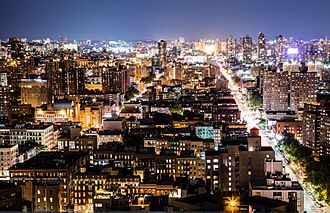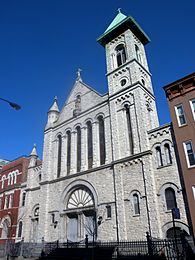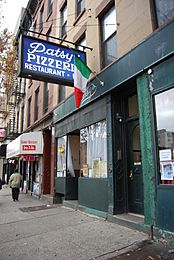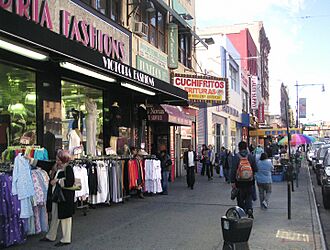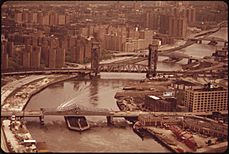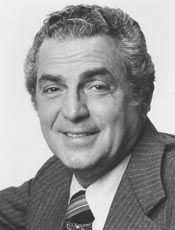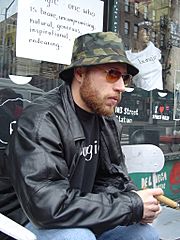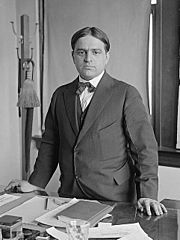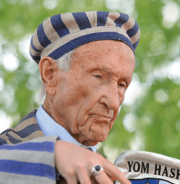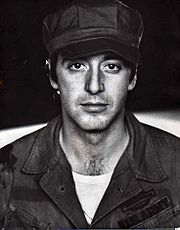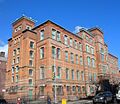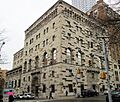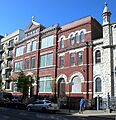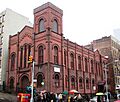East Harlem facts for kids
Quick facts for kids
East Harlem
|
|
|---|---|
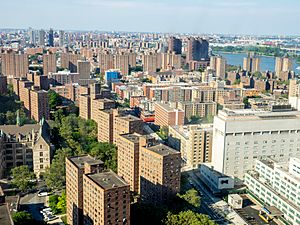
Second Avenue and 97th Street as seen from the south in 2019
|
|
| Country | |
| State | |
| City | New York City |
| Community District | Manhattan 11 |
| Population
(2010)
|
|
| • Total | 115,921 |
| Ethnicity | |
| • Hispanic | 52.1% |
| • Black | 35.7% |
| • White (non-Hispanic) | 7.3% |
| • Asian | 2.7% |
| • Other | 0.2% |
| Economics | |
| • Median income | ,480 |
| Time zone | UTC−5 (Eastern) |
| • Summer (DST) | UTC−4 (EDT) |
| ZIP Codes |
10029, 10035
|
| Area code | 212, 332, 646, and 917 |
East Harlem, also known as Spanish Harlem or El Barrio, is a lively neighborhood in Upper Manhattan, New York City. It's located north of the Upper East Side. Its borders are 96th Street to the south, Fifth Avenue to the west, and the East and Harlem Rivers to the east and north. Even though it's called East Harlem, it's usually seen as its own unique area, though it is part of the larger Harlem region.
This neighborhood is home to one of New York City's biggest Hispanic communities. Many residents are Puerto Ricans, but also Dominicans, Cubans, and Mexicans. East Harlem is famous for its impact on Latin freestyle and salsa music. You can also find traces of a past Italian community, once known as Italian Harlem. Recently, the number of Chinese people living here has grown a lot since 2000.
East Harlem has many public housing buildings, second only to Brownsville, Brooklyn. The neighborhood is currently seeing some changes, with new developments and businesses moving in.
East Harlem is part of Manhattan Community District 11. Its main ZIP Codes are 10029 and 10035. The New York City Police Department patrols the area.
Contents
A Look Back in Time: East Harlem's History
How East Harlem Grew Up
For most of the 1800s, the area that is now East Harlem was mostly countryside. But by the 1860s, small groups of homes started to appear. The arrival of elevated trains in 1879-1880 and the Lexington Avenue subway in 1919 helped the area grow into a city. This led to many apartment buildings and brownstones being built.
At first, East Harlem was settled by poor immigrants from Germany, Ireland, Scandinavia, and Eastern European Jewish communities. Around 1917, about 90,000 Jewish people lived there. In the 1870s, Italian immigrants also began to arrive. They started a small Italian neighborhood near 106th Street, which grew to include thousands of people by the mid-1880s. This area expanded north and west, becoming a mix of different ethnic groups.
In 1895, the Union Settlement Association started helping immigrant and low-income families. They offered programs like clubs for kids, sewing classes, and adult education.
Italian Harlem's Story
Soon, many people from Southern Italy and Sicily moved to East Harlem. This area became known as "Italian Harlem." It was the first part of Manhattan to be called a "Little Italy." The first Italians arrived in 1878 and settled near 115th Street.
In the 1920s and 1930s, Fiorello H. La Guardia, who later became mayor of New York City, represented Italian Harlem in Congress. By the 1930s, over 110,000 Italian-Americans lived in this busy neighborhood.
After World War II, many old buildings were torn down to make way for better housing. This caused families to move, but Italian Harlem remained a strong community for many years. Today, only a few older Italian-American residents still live there, mainly around Pleasant Avenue and the Our Lady of Mount Carmel Church.
Even so, some traditions and businesses from the old Italian neighborhood are still there. The annual Feast of Our Lady of Mount Carmel, New York City's first Italian feast, is still celebrated every August. Famous Italian places like Rao's restaurant (opened in 1896) and the original Patsy's Pizzeria (opened in 1933) are also still in East Harlem.
The Rise of Spanish Harlem
After the First World War, many Puerto Rican and Latin American immigrants moved to East Harlem. They created a new community around 110th Street and Lexington Avenue, which became known as "Spanish Harlem." As Italians moved out, more Nuyoricans (Puerto Ricans from New York) moved in during the 1940s and 1950s.
The growing Puerto Rican community shaped the neighborhood. They opened bodegas (small grocery stores) and botánicas (shops selling herbs and religious items). By the 1930s, there was a large indoor market called "La Marqueta" ("The Market") under the Park Avenue railroad tracks. By the 1950s, "Spanish Harlem" was used to describe the entire East Harlem area. Later, residents started calling it "El Barrio," which means "The Neighborhood."
Changes Over Time
In the 1950s and 1960s, many parts of East Harlem were rebuilt. The neighborhood faced tough times in the 1960s and 1970s, with crowded buildings and other challenges. In 1969 and 1970, a group called the Young Lords helped Latino and poor families by offering free breakfast and health clinics. They worked with the Black Panthers to ask for Puerto Rican independence and more power for the community.
By the early 2000s, East Harlem had become a very diverse place. About a third of the people were Puerto Rican. It has always been a neighborhood where many working-class families live.
Recently, East Harlem has seen gentrification, which means property values have gone up. This has brought some changes to who lives in the area. In 2019, the oldest part of the neighborhood, between 111th and 120th Streets, was added to the National Register of Historic Places.
Who Lives in East Harlem?
East Harlem is a diverse community. The New York City Department of City Planning divides it into two areas: East Harlem North and East Harlem South. In 2010, about 115,921 people lived in East Harlem.
The neighborhood has a large Hispanic or Latino population, making up about half of the residents. There are also many African American residents. In recent years, the number of Asian residents has grown a lot, especially Chinese people. This is partly because rents in Lower Manhattan's Chinatown have increased, leading some to move to East Harlem. The number of White residents has also increased.
East Harlem is mostly a low to middle-income area. Many residents are first or second-generation immigrants from places like Puerto Rico, the Dominican Republic, Cuba, Mexico, and Central America. It has one of the highest numbers of Puerto Ricans in New York City.
Homes in East Harlem
East Harlem has many public housing complexes. It has the second-highest number of public housing units in the United States. These buildings are managed by the New York City Housing Authority (NYCHA). Many older tenement buildings are also found between these larger developments.
After many fires in the 1970s damaged buildings, the city started to fix up abandoned buildings. These were then used for low-income housing. Even with new developments, some apartment buildings are kept empty by their owners. This is sometimes done so they can rent them out later for higher prices.
Public Housing Projects
There are 24 New York City Housing Authority (NYCHA) developments in East Harlem. Over 25% of the people in East Harlem live in these public housing units. Some examples include:
- East 120th Street Rehab
- East River Houses
- George Washington Carver Houses
- James Weldon Johnson Houses
- Lexington Houses
- Metro North Plaza
- President Thomas Jefferson Houses
- Robert F. Wagner Houses
Other Homes
Other types of housing include:
- Taino Towers – Four tall buildings with 656 apartments, opened in 1979.
- A new 68-story building at 321 East 96th Street was approved in 2017. It will have schools, shops, and about 1,100 apartments.
Work and Business
East Harlem is home to Metropolis, one of the few major television studios north of midtown Manhattan. Shows like BET's 106 & Park and Chappelle's Show have been filmed there. MediaNoche, a media gallery and digital film studio, opened in 2003. It showcases art and films related to Puerto Rican history and culture.
Staying Safe: Fire Services
The New York City Fire Department (FDNY) has four fire stations in East Harlem to keep the community safe:
- Engine Company 35/Ladder Company 14/Battalion 12 – 2282 Third Avenue
- Engine Company 53/Ladder Company 43 – 1836 Third Avenue
- Engine Company 58/Ladder Company 26 – 1367 Fifth Avenue
- Engine Company 91 – 242 East 111th Street
Mail and ZIP Codes
East Harlem uses two main ZIP Codes: 10029 for the area south of 116th Street and 10035 for the area north of 116th Street. The United States Postal Service has two post offices nearby:
- Hellgate Station – 153 East 110th Street
- Triborough Finance New Station – 118 East 124th Street
Learning in East Harlem

East Harlem has many schools, but fewer residents have a college degree compared to other parts of New York City. In 2018, about 38% of residents had a college education or higher. The good news is that student success in math and reading has improved over the years.
Sometimes, schools in the city use metal detectors and ID cards for entry.
Schools in the Neighborhood
The New York City Department of Education runs public schools in East Harlem. Here are some of the elementary schools:
- Central Park East I
- James Weldon Johnson School
- PS 7 Samuel Stern
- PS 30 Hernandez Hughes
- PS 83 Luis Munoz Rivera
- PS 96 Joseph Lanzetta
- PS 102 Jacques Cartier
- PS 108 Assemblyman Angelo Del Toro Educational Com
- PS 112 Jose Celso Barbosa
- PS 133 Fred R Moore
- PS 171 Patrick Henry
- River East Elementary School
- Tag Young Scholars
Middle schools include:
- Esperanza Preparatory Academy
- Isaac Newton MS For Math And Science
- MS 224 Manhattan East School For Arts And Academy
- Renaissance School of the Arts
- Young Women's Leadership School, East Harlem
High schools in East Harlem are:
- Harlem Renaissance High School
- Manhattan Center for Science and Mathematics
- PS 79 Horan School
- The Heritage School
There are also public charter schools like Success Academy Harlem 2 and Harlem Village Academy.
Libraries for Everyone
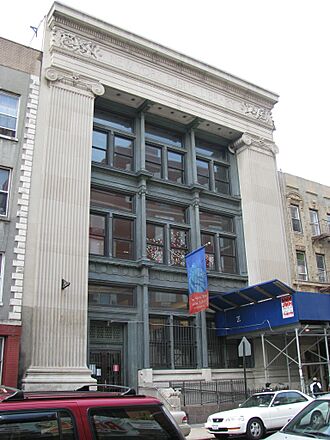
The New York Public Library (NYPL) has two branches in East Harlem:
- The Aguilar branch at 174 East 110th Street. It opened in 1903 and was named after author Grace Aguilar.
- The 125th Street branch at 224 East 125th Street. It opened in 1901.
Other nearby NYPL branches include the 96th Street branch and the Harlem branch.
Getting Around: Transportation
The Harlem River separates East Harlem from the Bronx. Several bridges connect the two areas:
- The Willis Avenue Bridge (for cars going north)
- The Third Avenue Bridge (for cars going south)
- The Madison Avenue Bridge
The Wards Island Bridge (also called the 103rd Street Footbridge) connects Manhattan to Wards Island. The Triborough Bridge (officially the Robert F. Kennedy Bridge) connects East Harlem to Queens and the Bronx.
Public transportation is provided by the Metropolitan Transportation Authority.
- The New York City Subway's IRT Lexington Avenue Line runs through East Harlem. You can find express trains at 125th Street (4 5 6 <6> routes) and local trains at 116th Street, 110th Street, 103rd Street, and 96th Street (6 <6> routes).
- There is also a Second Avenue Subway station at 96th Street on the Q route line.
- Many MTA buses serve East Harlem, including the M15, M15 SBS, M35, M60 SBS, M96, M98, M101, M102, M103, M106, M116 and M125 routes.
- The Metro-North Railroad has a commuter rail station at Harlem–125th Street. From here, you can take trains to the Lower Hudson Valley and Connecticut.
Famous People from East Harlem
Many well-known people have come from East Harlem, including:
- Jack Agüeros (1934–2014), community activist and writer.
- Marc Anthony (born 1968), a famous singer.
- ASAP Rocky (born 1988), a popular rapper.
- Ray Barretto (1929–2006), a talented musician.
- Mario Biaggi (1917-2015), a decorated policeman and US Congressman.
- Joe Budden (born 1980), a rapper.
- Cam'ron (born 1976), another well-known rapper.
- Bobby Darin (1936–1973), a famous singer.
- Julia de Burgos (1914–1953), a celebrated poet.
- James De La Vega (c. 1974), a visual artist known for his street art.
- Erik Estrada (born 1949), an actor.
- Fiorello H. La Guardia (1882–1947), a former Mayor of New York City.
- Burt Lancaster (1913–1994), a famous actor.
- Vito Marcantonio (1902–1954), a lawyer and politician.
- Edward Mosberg (1926-2022), a Holocaust survivor and educator.
- Al Pacino (born 1940), a highly respected actor.
- Tito Puente (1923–2000), a legendary musician.
- Jonas Salk (1914-1995), the scientist who developed the polio vaccine.
- Tupac Shakur (1971–1996), an influential rapper and actor.
- Ronnie Spector (1943–2021), a singer from the group The Ronettes.
- Piri Thomas (1928–2011), a writer.
Images for kids
-
El Museo del Barrio
(1230 Fifth Ave.) -
New York Public Library 125th St. Branch
(224 East 125th St.)
See also
 In Spanish: Harlem del Este para niños
In Spanish: Harlem del Este para niños


